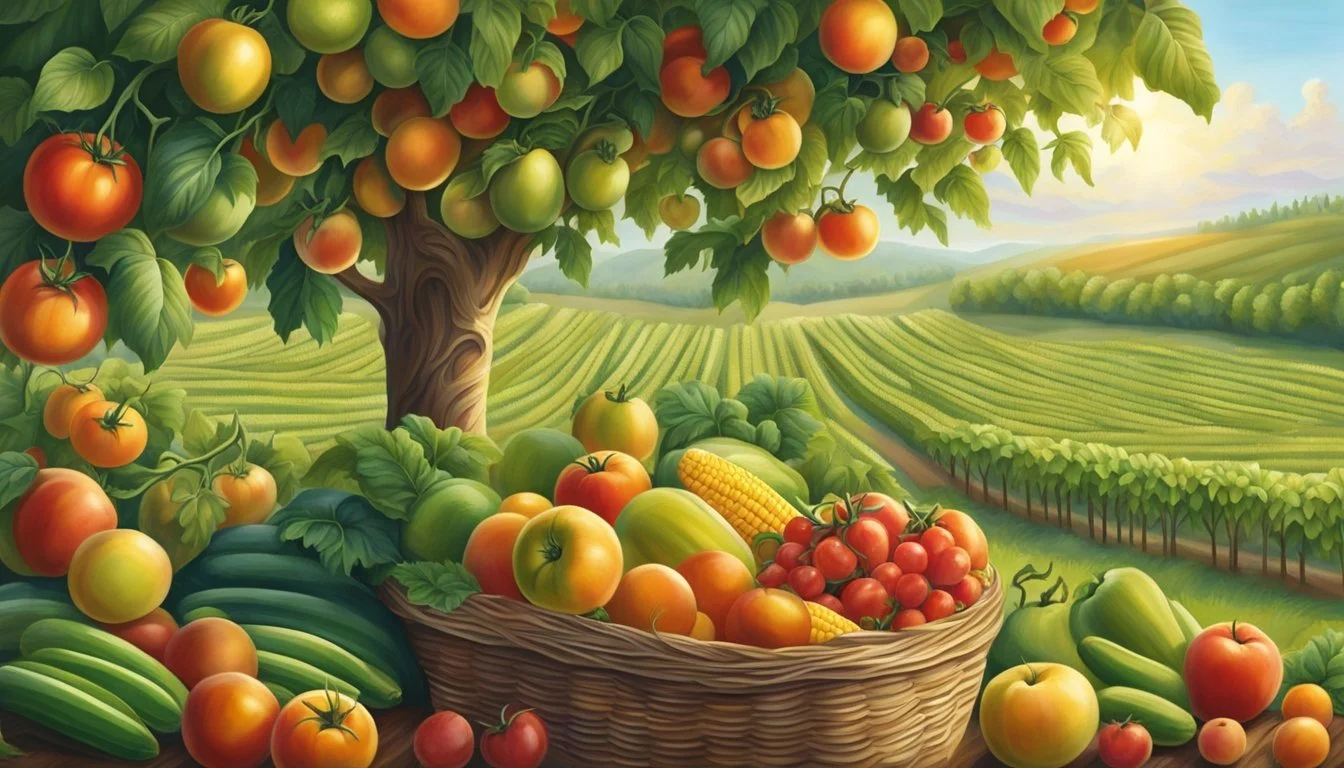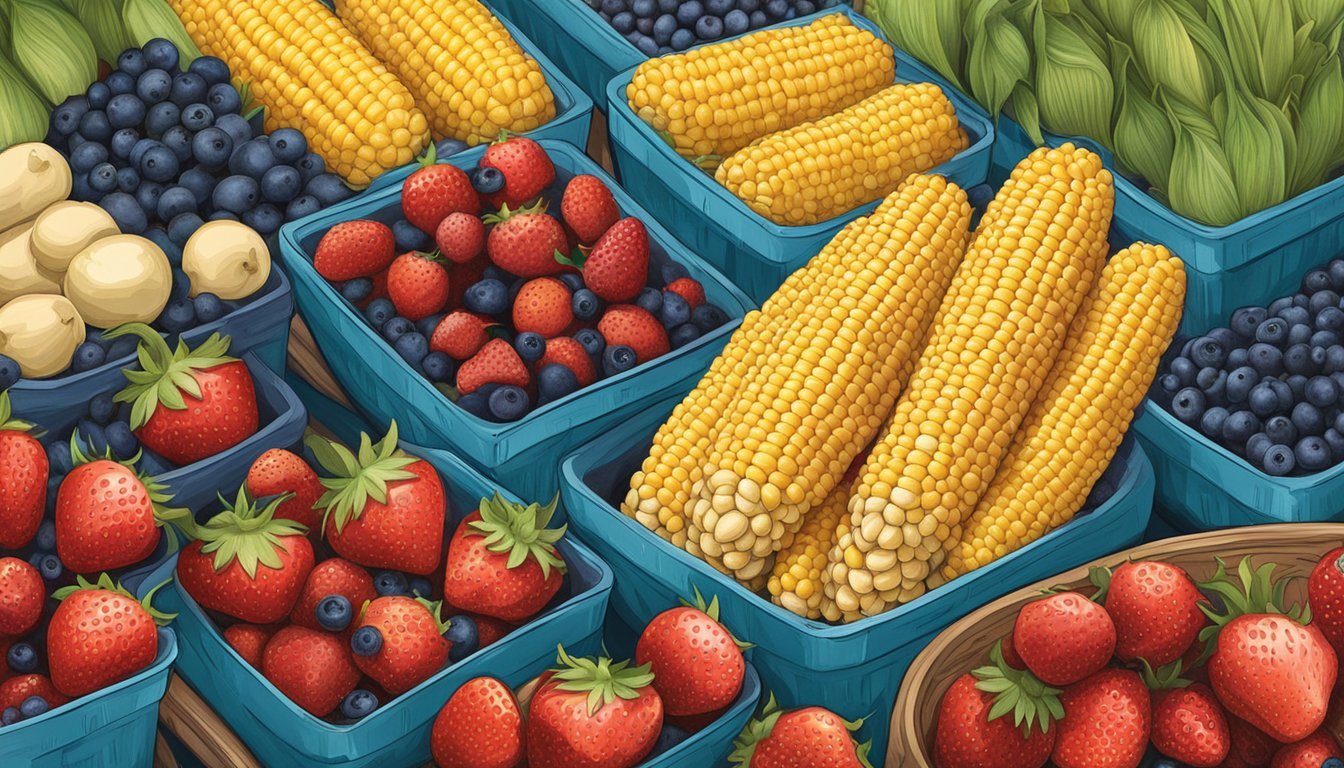North Dakota Seasonal Fruit & Vegetables in August
Your Fresh Guide
This Article is Part of our North Dakota Seasonal Fruit & Veg Calendar
August is a month where the fields and market stalls of North Dakota burst with the abundance of seasonal produce. In this northern state, the growing season hits a peak as fields are lush and gardens are at their most bountiful. With long summer days and warm temperatures, local farmers work diligently to harvest their crops, ensuring a fresh supply of fruits and vegetables to the region.
During this period, consumers have the opportunity to enjoy a variety of fresh produce that includes both fruits and vegetables. The seasonal selections not only offer a palette of flavors and textures but are also packed with nutrition. Among the available produce, one can find crisp vegetables like carrots, beets, and cauliflower and savor the sweetness of fruits like melons and plums.
In North Dakota, the emphasis on farm-to-table eating is palpable during August as the state's agricultural prowess is showcased through their seasonal offerings. The availability of fresh, locally grown produce supports not only a healthier lifestyle but also the local economy. It's an ideal time for residents and visitors alike to explore the state's seasonal harvests and incorporate them into their culinary repertoire.
Seasonal Availability
In North Dakota, August marks a vibrant period of abundance where a variety of fresh produce reaches its peak harvest period, offering rich flavors and nutritional benefits.
Summer Harvest
The heart of summer in North Dakota boasts a bountiful selection of vegetables and fruits. The warm weather contributes to the successful growth and harvest of a range of produce. Home gardeners and local farmers markets are brimming with tomatoes, peppers, and summer squash. These vegetables are collected at their ripest, making them perfect for both fresh salads and cooking.
Cucumbers (how long do cucumbers last?) and beans have also matured by this time, with the former being a staple for refreshing salads and the latter appearing in various forms, such as green beans or wax beans. Meanwhile, sweet corn stands as a sweet highlight of North Dakota's summer harvest, often found at roadside stands and local markets.
Late Summer Varieties
As summer progresses into its later stage, the availability of fruits and vegetables begins to transition. Watermelon and cantaloupe (how long does cantaloupe last?), symbols of late summer freshness, are generally harvested in August. These juicy, hydrating fruits serve as both a treat on hot days and a flavorful complement to summer dishes.
Additionally, as one moves towards the end of the summer season, the first of the eggplants (What wine goes well with eggplant?) start to make an appearance. Often used in a variety of culinary dishes, eggplants (What wine goes well with eggplant?) add a unique texture and flavor profile to meals.
Though typically associated with fall, the initial batches of sweet potatoes are harvested towards the end of August, indicating the impending change of seasons from summer to autumn. Their versatility allows them to be used in numerous recipes, from baked goods to savory entrées.
Health Benefits
Consuming seasonal fruits and vegetables in August ensures that residents of North Dakota enjoy the freshest produce at its nutritional peak. These food items are not only at their best in flavor but also offer a range of health benefits due to their high nutrient content.
Nutrient-Rich Produce
Seasonal vegetables such as kale and potatoes, and fruits like blueberries and blackberries (how long do blackberries last?) available in North Dakota during August, are especially nutrient-dense.
Kale: A powerhouse of vitamins A, C, and K, kale supports immune function, vision health, and bone strength.
Potatoes: They are a good source of vitamin C, potassium, and dietary fiber, which are essential for heart health and digestion.
Fruit is equally beneficial:
Blueberries: Rich in antioxidants and vitamin C, blueberries help in protecting the body from oxidative stress and support the immune system.
Blackberries: These berries are high in vitamins C and K, fiber, and manganese, aiding in everything from maintaining healthy skin to optimal bone health.
The fresh produce's flavor is at its peak during the season, encouraging more consumption and providing the body with various essential nutrients. Eating such produce can contribute to a well-rounded diet that supports overall health.
Gardening Tips
In August, gardeners in North Dakota need to employ strategies that accommodate the region's short growing season and variation in hardiness zones. They must also be vigilant in pest and disease management to ensure a healthy harvest as the season transitions towards September.
Optimal Planting Strategies
For North Dakota's hardiness zones 3 and 4, timing is crucial. Gardeners should focus on planting cold-hardy and quick-maturing crops that can withstand early frost. It's recommended to consult a regional planting calendar to ensure that seedlings are introduced to the garden at the optimal time. Data from previous years can help refine these planting dates.
Short-season vegetables:
Broccoli
Lettuce (Romaine and Iceberg)
Radishes
These vegetables are known for being easy to grow in North Dakota and have a good chance of being harvested before the colder temperatures of late September.
Pest and Disease Management
North Dakota gardeners need to protect their crops from pests like deer, rabbits, and squirrels, as well as insect invaders. Fencing and netting are effective physical barriers against larger animals. For insect control, the use of insect nets or organic pesticides can help prevent infestations.
Common Pests:
Deer
Rabbits
Squirrels
Disease prevention is just as crucial, and one should select disease-resistant varieties when available. Regular inspection of the garden and removal of diseased plant material helps reduce the spread of infections. Gardeners should avoid over-watering and ensure proper air circulation around plants to minimize the risk of fungal diseases.
Local Farming and Markets
In August, North Dakota's local farming and markets are at their peak of activity, offering a variety of fresh produce. Cities like Bismarck, Fargo, Grand Forks, Minot, and Williston become hubs for locally grown fruits and vegetables, with farmers markets and CSA programs flourishing during this period.
Community Supported Agriculture
Community Supported Agriculture, or CSA, is a pivotal component of North Dakota's local food economy, especially in August. Members of the community purchase shares of a farm's harvest in advance, providing farmers with stable income and participants with regular allotments of fresh produce throughout the season.
Popular CSA Produce in August:
Fruits: Cantaloupes, Watermelon
Vegetables: Asparagus, Beans, Beets, Broccoli, Brussels Sprouts, Cabbage, Carrots, Cauliflower
Key Regions for CSA:
Bismarck: Amid the central region, Bismarck's CSA programs boast a wide selection of vegetables, reflecting the city's agricultural diversity.
Fargo: As North Dakota's most populous city, Fargo's CSA options are abundant, providing an array of seasonal produce to its community members.
Grand Forks: Situated in the fertile Red River Valley, Grand Forks offers a rich assortment of vegetables through its CSA programs catering to local tastes.
Minot and Williston: These cities' CSAs deliver a more curated selection of produce, meeting the demands of northwestern North Dakota's inhabitants.
CSA Benefits:
For Consumers: They receive nutritious, freshly-picked produce and gain a closer connection to the local food system.
For Farmers: They are ensured a reliable market for their crops, helping to mitigate financial risks.
Local farming and CSA programs in North Dakota foster a robust relationship between growers and consumers, reinforcing the community's support for sustainable agricultural practices and the local economy.
Preservation Techniques
With North Dakota's abundant August harvest, specifically focusing on tomatoes, cucumbers, and peppers, preservation techniques such as canning, freezing, and preparing jams and sauces become critical. These methods ensure that the freshness of summer produce is captured and savored throughout the year.
Canning and Freezing
Canning: This traditional method of food preservation involves placing fruits and vegetables in jars and heating them to a temperature that destroys microorganisms. The seal that forms during the cooling process prevents new bacteria from entering and spoiling the food.
Tomatoes can be canned whole, diced, or as tomato sauce.
Cucumbers are typically canned as pickles.
Peppers can be canned alone or added to salsas and sauces for flavor enhancement.
Freezing: By quickly lowering the temperature, freezing maintains the quality of produce by slowing down enzyme activity that can cause spoilage.
Tomatoes: It is recommended to freeze them after peeling for better texture upon thawing.
Cucumbers: Not ideal for freezing, as they contain a lot of water and become mushy.
Peppers: Freeze in slices or dices after removing seeds and membranes.
Preparing Jams and Sauces
Jams: A process where fruits are cooked with sugar to the point of gelling. Pepper jams are a unique twist to traditional sweet jams, offering a combination of heat and sweet.
Pepper Jam: Requires peppers, sugar, vinegar, and pectin.
Sauces: Hearty, savory sauces like spaghetti sauce or salsa make excellent use of ripe tomatoes and peppers, preserving their peak flavors.
Spaghetti Sauce: Typically contains a base of tomatoes, onions, garlic, and herbs.
Salsa: A blend of tomatoes, peppers, onions, and spices, kept for freshness.
By applying these preservation techniques, gardeners and cooks in North Dakota can extend the taste of August far beyond the summer months.
Seasonal Recipes
In August, North Dakota's bounty is ripe for the picking, providing an array of ingredients perfect for fresh, vibrant dishes. From farm-to-table salads to rich desserts, the recipes in this section showcase how to utilize August's freshest produce.
Fresh Salads and Starters
North Dakota August gardens offer greens and garnishes ideal for refreshing beginnings. A salad combining crisp lettuce, juicy radishes, and sweet honeydew chunks creates a symphony of textures. Toss in some freshly chopped herbs for a burst of flavor. Another starter to consider is a chilled melon soup; blend ripe honeydew with lime juice and mint for a light appetizer on a warm summer evening.
Salad with Honeydew and Radishes
Ingredients: Lettuce, Radishes, Honeydew, Herbs
Dressing: Olive oil, Lemon juice, Salt, Pepper
Chilled Melon Soup
Ingredients: Honeydew, Lime juice, Fresh mint, Water
Main Course Creations
The main courses in August are a celebration of the garden’s heartier offerings. Grilled eggplant (What wine goes well with grilled eggplant?) slices make the perfect base for a vegetable stack, layered with summer squash, roasted red peppers, and a sprinkle of Parmesan cheese. Their natural sweetness can be enhanced with a balsamic glaze drizzle. Alternatively, whip up a batch of Baba Ganoush to serve alongside grilled chicken or fish for a smoky, rich dip that complements the main dish.
Grilled Eggplant and Summer Squash Stack
Ingredients: Eggplant, Summer Squash, Red peppers, Parmesan cheese
Extras: Balsamic glaze
Baba Ganoush
Ingredients: Eggplant, Tahini, Garlic, Lemon juice
Sweet Summer Desserts
August’s ripe melons serve as the foundation for desserts that end the meal on a high note. Try making a honeydew sorbet, a simple yet satisfying treat to cool down on hot summer days. For something more decadent, bake a summer squash cake, moist and flavorful, topped with a cream cheese (how long does cream cheese last?) frosting. Both desserts highlight the versatility and natural sweetness of North Dakota's seasonal produce.
Honeydew Sorbet
Ingredients: Honeydew, Sugar, Lemon juice, Water
Summer Squash Cake
Ingredients: Summer Squash, Flour, Eggs, Sugar, Baking powder
Frosting: Cream cheese, Powdered sugar, Vanilla extract








